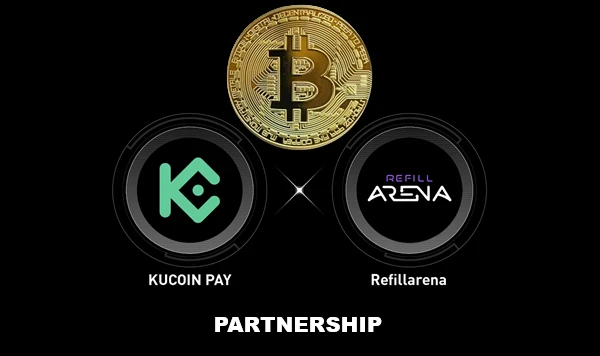


Cryptocurrency payments in e-commerce are accelerating in 2025, with stablecoins easing volatility and blockchains reducing cross-border payment delays. A recent survey shows merchants planning a 25 percent increase in adoption this year as digital ledgers outpace traditional wire transfers.
Europe and Asia, with clearer regulations, are leading as retailers incorporate tokens for purchases such as mobile data and entertainment. The trend builds on last year’s momentum, when privacy-focused tools drew younger consumers seeking alternatives to card-based payments.
KuCoin Pay’s move with Refillarena fits squarely into that flow, announced September 23, 2025. The exchange’s arm for quick, fee-light transfers now fuels purchases on the retailer’s site, targeting needs that hit close to home.
Partnership Mechanics
KuCoin Pay powers the checkout process, enabling buyers to pay in seconds by scanning a QR code or connecting their wallets. Refillarena’s catalog includes over 30,000 digital items, from Netflix and Xbox vouchers to eSIMs and mobile top-ups, available in more than 180 countries.
Its infrastructure already accommodates over 300 cryptocurrencies in addition to dollars and euros, making KuCoin integration a low-friction extension rather than a reinvention.
is leaning on familiar tactics: a launch promotion lasting through October 23 provides a 15 percent discount on select transactions, capped at $10. This strategy follows a pattern seen in past rollouts—September’s collaboration with DFX.swiss integrated crypto payments into over 100 European grocery chains, while August’s 2Game Digital campaign offered 20 percent savings on gaming content.
Each step expands consumer comfort, gradually moving crypto from niche perks into daily spending habits.
Refillarena CEO Ahmed AlBadri highlighted how KuCoin Pay bolsters safeguards and global access, turning complex swaps into taps that rival app-based banking. The retailer, rooted in web3 since its early days, focuses on digital-only drops to dodge shipping snags, a model that has fueled steady growth amid crypto’s ups and downs.
Refillarena’s Foundation
Launched as a mobile-first hub for virtual goods, Refillarena carved a niche by blending crypto with quick fulfillment. Users grab airtime for remote calls or fashion e-gifts without conversion waits, a draw in regions where banks lag.
Its app supports lightning-fast networks for assets like Bitcoin, drawing praise in reviews for reliability even during peak loads.
This base made it ripe for exchange pairings. Prior to KuCoin, Refillarena leaned on gateways like Binance Pay for fiat-crypto mixes, but the new layer adds KuCoin’s 40 million-strong network. That reach amplifies Refillarena’s aim to scale its catalog, much like its November 2024 push during Bitcoin’s rally above $75,000, when traffic spiked on token-backed buys.
Sector Ripples
This agreement arrives during a broader push to link crypto with everyday spending. Stablecoins now account for the majority of retail transaction volume, a trend driven by their ability to lock in value and reduce volatility risks for merchants. Analysts project blockchain-based payments to drive efficiency in 2025, with real-time settlement replacing the days-long clearing cycles of legacy e-commerce systems.
KuCoin’s move looks pretty different when you stack it against the competition. Binance Pay hooked up with Zapper on September 9, letting people pay in crypto at 31,000 spots across
South Africa, from gas stations to cafes, and local volumes shot up in weeks. Coinbase Commerce went another route in June, adding USDC payments to Shopify so millions of U.S. stores could take crypto, with transaction costs under a cent on Base. KuCoin is not chasing that scale yet. Instead, it’s testing digital-focused use cases to see how far utility can go.
The sequence is intentional: five integrations since April point to a strategy of incremental build-out. Uquid’s April overhaul positioned KuCoin in digital retail, while Umy’s August link extended reach into travel. Layered together, these moves form an expanding network of spending channels, designed to deepen user stickiness even when trading activity cools.
Pitfalls and Possibilities
Fees and swings still deter some, but instant conversions and regulatory nods in key markets soften those edges. Asia’s frameworks, tightened mid-year, now favor gateways with built-in compliance, a win for setups like this. For buyers, the privacy of pseudonymous ledgers appeals over traced cards, pulling in demographics that view crypto as a shield.
Forward, these links could lift crypto’s e-commerce slice from low single digits to teens by 2026, if promotions convert trials to habits. Refillarena plans 50,000 items next year, eyeing more exchange hooks. KuCoin Pay’s lead Raymond Ngai frames it as cash-like practicality, a goal that past volatility tested but current tools fortify.
This KuCoin-Refillarena knot tests crypto’s grip on the $6 trillion online sales arena. As wallets fund routine top-ups, the shift from speculation to spend gains ground, potentially pulling more assets into play and pressuring holdouts to follow suit.
He has worked with several companies in the past including Economy Watch, and Milkroad. Finds writing for BitEdge highly satisfying as he gets an opportunity to share his knowledge with a broad community of gamblers.
Nationality
Kenyan
Lives In
Cape Town
University
Kenyatta University and USIU
Degree
Economics, Finance and Journalism


Facts Checked by Maryam Jinadu

 Fact checked by
Fact checked by 
 eabungana@gmail.com
eabungana@gmail.com 